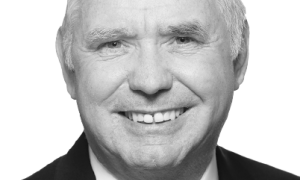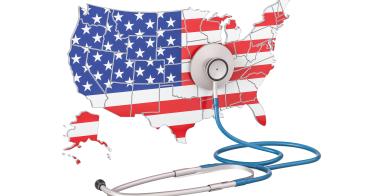Yes, it can get worse, much worse.
Washington’s deficit spending has fueled punishing inflation, but self-styled “progressives” in Congress remain fully committed to ratcheting up federal spending and debt even more.
Vermont Sen. Bernie Sanders recently chaired a Senate Budget Committee hearing on his “Medicare for All” proposal. Like his earlier version, the Senate bill would abolish virtually all private and employer-sponsored health insurance, eliminate Medicaid and even Medicare itself, and establish a “single payer” system of national health insurance.
Most House Democrats are co-sponsoring similar legislation. Their basic proposition is that their legislation, which will upend coverage of 90 percent of the population, will guarantee higher quality care for all at lower national and personal costs.
>>> Health Care: Time to Go on Offense
The Sanders bill, like the House Democrats’ companion bill, is especially notable not for what it contains but for what is missing: the crucial financing provisions.
Without specifying the kind or the size of taxes required to fund the program, neither the Congressional Budget Office nor independent economists can score the bill and provide anything close to a precise estimate of its effect on the federal budget, the economy or taxpayers. The economic effect is mostly left to educated guesswork.
Educated guess-workers exist. Testifying before the Senate Budget Committee, CBO Director Phillip Swagel reported that the agency had not analyzed Sanders’ bill but had previously conducted an analysis of five versions of the “single payer” universal coverage program.
Replacing current programs with any of the five “single payer” options would, according to the CBO analysis, require massive taxpayer subsidies: between $1.5 trillion and $3 trillion in 2030 alone. Moreover, new demand would outstrip the limited supply of medical services, resulting in “congestion” in the system and “delays and foregone care.” Curious what that looks like? Check out Britain and Canada.
Americans will be left poorer, too. Whether the government health program is financed by an income tax or payroll tax, according to CBO, America’s gross domestic product, the nation’s total production of goods and services, would be “approximately 1 percent to 10 percent lower by 2030” than under current law.
Why? Says CBO: “The net reductions in GDP would occur primarily because of the effects of increased taxes on labor and capital income. Taxes on labor income reduce after-tax wages, so they reduce the return on each additional hour worked. … In CBO’s assessment, therefore, higher labor taxes tend to reduce the number of hours worked in the economy. Higher taxes on capital income, such as dividends and capital gains, lower the average after-tax rate of return on private wealth holdings (or the return on investment), which reduces the incentive to save and invest and leads to reductions in the capital stock. Those effects lead, in turn, to lower income.”
Printing money to cover the cost is a dead end. Says CBO: “Perpetually financing any of the single-payer systems CBO analyzed through increased borrowing—without a corresponding increase in revenues or a reduction in other spending at some point in the future—would be unsustainable.”
And forget “soaking the rich.” Even they aren’t rich enough to cover the ballooning bills racked up under Medicare for All.
Testifying at the same Senate hearing, Dr. Charles Blahous, a former trustee of the Medicare program and scholar at the Mercatus Center, said that to provide “Medicare for All” level of benefits and services would require spending between $32.6 trillion and $38.8 trillion, or about $120,000 per person, above and beyond any administrative cost-cutting measures. Even at the lower estimate, Blahous observed, a “doubling of all currently projected federal individual and corporate income taxes would be insufficient to finance the added federal costs of enacting M4A” (“Medicare for All”).
The congressional “progressives” assure us, however, that individuals and families—no longer paying private insurance premiums and deductibles—would still come out ahead with a tax-financed government health program.
Don’t bet on it. Examining previous “Medicare for All” legislation, Heritage Foundation analysts concluded that a “single-payer” program would require a tax of 21.2 percent of earnings (on top of current federal, state and local taxes), hitting nearly two-thirds of American households, meaning that 73.5 percent of Americans would pay more for healthcare than they do today.
>>> California Nightmare: What to Know About Left’s Next Run at Single-Payer Health Care
Recognizing the political difficulty of abolishing nearly all existing private and public health insurance and substituting a centralized “single payer” program, some lawmakers, including Sanders, propose a watered-down version that would reduce the normal age of eligibility from 65 to 60. Assuming implementation of that policy in 2026, CBO and the Joint Committee on Taxation estimate that over five years 7.3 million people—about twice the population of Oklahoma—would enroll in the financially troubled Medicare program.
Of that 7.3 million, CBO and JCT estimate that 4.8 million would have otherwise had private, employer-sponsored health insurance coverage. In short, the policy would amount to a crowd-out of existing coverage and private payment at the expense of the taxpayer for that segment of the population, while adding an additional $155 billion (about $480 per person in the United States) to the federal deficit.
Washington’s frenetic spending is already exacting an exorbitant price. Because of bad federal policy, ordinary Americans are suffering from soaring inflation. They are being threatened by an impending recession and are witnessing a steady depreciation of their savings and retirement income. Over the horizon, Americans’ financial future is already darkened by accumulating deficits and dangerous debt, now exceeding $30.4 trillion—about $94,000 per person in the country.
Ignore silly promises of “free care” for all. If congressional “progressives” ever succeed in taking over American healthcare—nearly one-fifth of the American economy—our personal and public finances, bad as they are right now, will get much, much worse.
This piece originally appeared in Inside Sources




